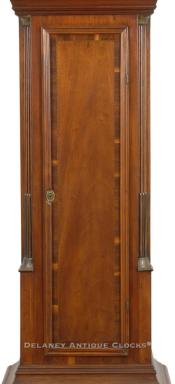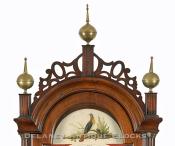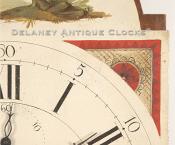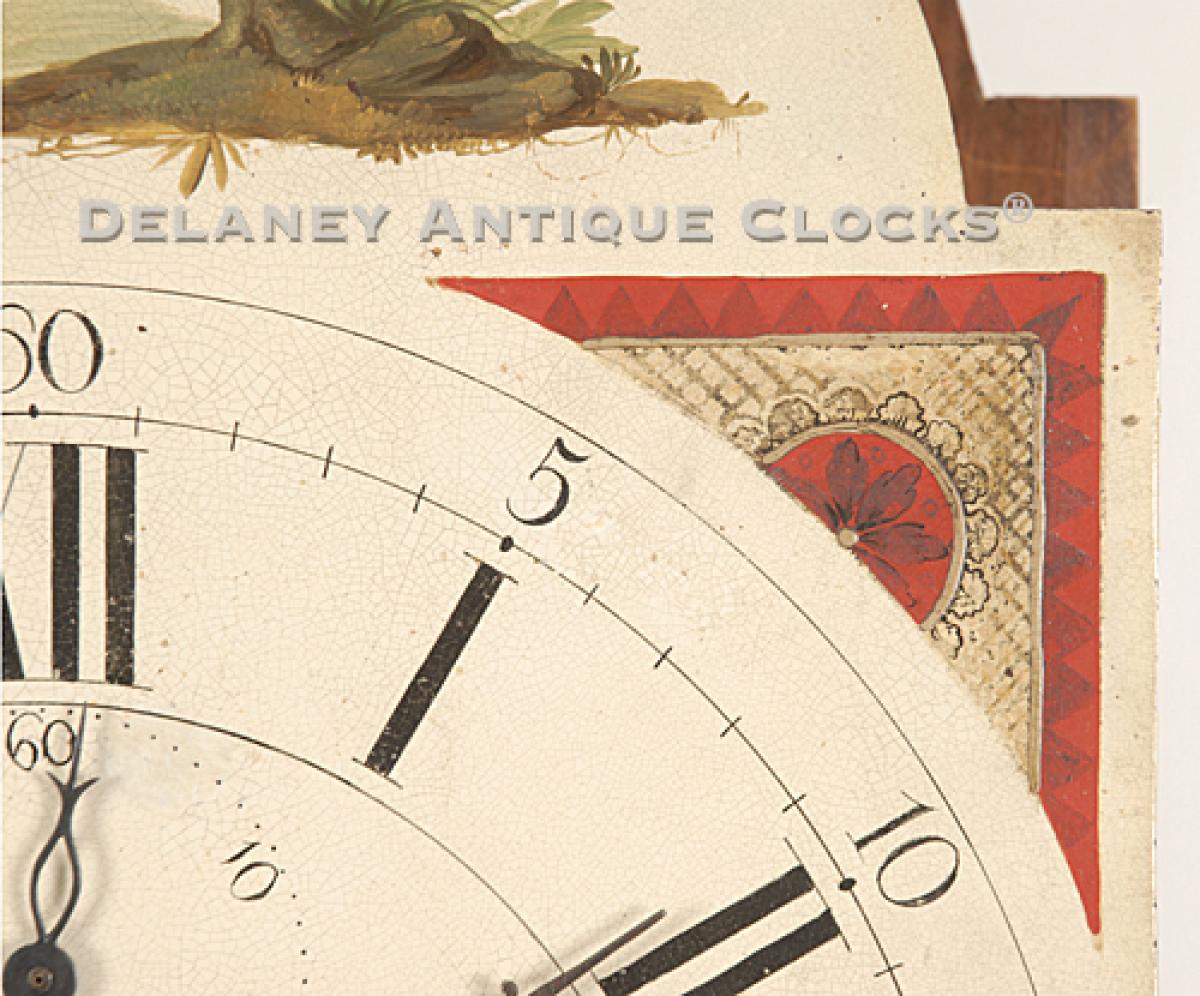A fine and rare Federal mahogany and rosewood cross-banded tall case clock by William Crane, Canton, Mass, circa 1815. XXSL-33.
This is a handsome clock case. The case is nicely proportioned and was produced for the very Canton, Massachusetts clockmaker William Crane.
This case is constructed in mahogany and was made locally, in Southeastern Massachusetts. Its formatting closely resembles the best examples of the period from Boston. The sophisticated wood selections, excellent proportions and graceful lines of the tall French feet are far from provincial. The distinctive fretwork is clearly a regional form that does give a clue to the origins of the case. This fine example is elevated on flared French style feet. This form transitions into a double drop apron in the center. The feet are visually separated from the base by a broad band of line inlay. The base is framed with a cross-banded border. The rosewood used for this decorative detail varies in color. The lighter areas attract ones attention. This formatting is also used in the design of the waist door. The door is also trimmed with an applied molding. Through this door, one can access the brass faced pendulum bob and the two drive weights. The corners of the waist are fitted with brass stop fluted quarter columns. These terminate at each end in brass quarter capitals. The columns are supported on line inlaid plinths. The hood features a distinctive south eastern Massachusetts fret-work pattern. Three fluted plinths each support the brass ball and spire finials. Brass stop-fluted hood columns flank the line inlaid door. This open to access the painted dial.
This painted iron dial was manufactured in Boston by Spencer Nolen and measure 12 inches across. The colors used in the four spandrel areas are hallmarks of this ornamental artist and his workshop. This complexity of the design illustrates the high level of skill. The spandrel areas are decorated with geometric feature or patterns. An exotic song bird set in a landscape is depicted in the lunette. It is colorfully depicted. This dial displays the time in a traditional format having large Roman style hour numerals, a dashed minute track and Arabic five minute marker are positioned at the appropriate locations. A subsidiary seconds dial is located below the Roman hour numeral XII. This dial is signed by the Clockmaker. It reads, "W. Crane \/ CANTON."
This fine movement is constructed in brass and is good quality. Four turned pillars support the two brass plates. Hardened steel shafts support the polished steel pinions and brass gearing. The winding drums are grooved. The escapement is designed as a recoil format. The movement is weight driven and designed to run eight days on a full wind. It is a two train or a time and strike design having a rack and snail striking system. As a result, it will strike each hour on the hour. This is done on a cast iron bell which is mounted above the movement.
This fine clock was made circa 1815. The case stands approximately 96 inches tall, 19 inches and 10 inches deep.
Inventory Number XXSL-33.
Clockmaker, watchmaker, gunsmith and brass founder.
William Crane was born in Stoughton, Massachusetts on August 12, 1749 and died there on May 8, 1820. In about 1780, William moved to Canton, MA on Packeen Road now Dedham Street and and worked as a clockmaker, gunsmith and brass founder. He had at least four children. His son Simeon (1774-1821) was also a clockmaker. Two of William's daughters married the clockmaking brothers Henry and Elijah Morse. In 1808, Hannah Crane married Elijah Morse and Lucy Crane married Henry Morse Jr in 1809. The Morse brothers are thought to have apprenticed to Crane. In 1810, William's son Simeon may have been in business with his father in Canton.
















